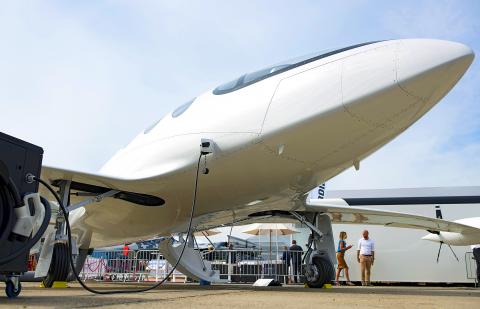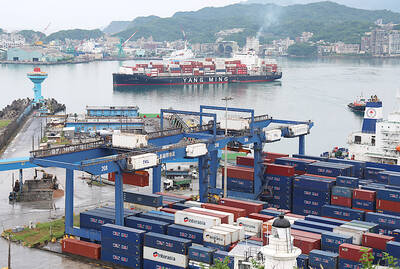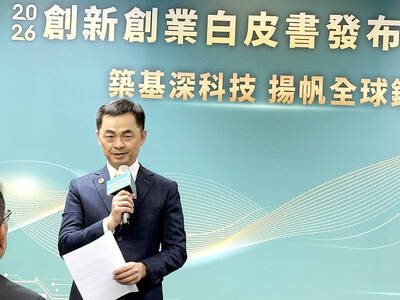An all-electric commuter plane and a small Airbus-backed hybrid are among aircraft programs being touted at the International Paris Air Show, as the industry tries to convince a skeptical public it can deliver on a pledge to halve carbon emissions by 2050.
Israeli start-up Eviation has wheeled out Alice, a battery-powered nine-seater due for its maiden flight later this year, while Airbus and suppliers Safran SA and Daher are showing a scale model of their planned EcoPulse, a similarly sized short-hopper that packs a fuel tank, as well as batteries.
The electric debuts come as European finance ministers are expected later this week to discuss ending aviation fuel tax exemptions to curb greenhouse emissions.

Photo: AFP
The spread of social media posts “flight-shaming” air travel has also jangled executives’ nerves and added pressure to electrify, following the auto industry’s lead.
However, unlike cars, electric planes must heft their power packs aloft — a reality that limits them to small aircraft on the shortest routes, as even their proponents concede.
“The impact of battery weight is an order of magnitude more severe for us,” said Stephane Cueille, Safran’s head of research, technology and innovation.

Photo: EPA-EFE
The EcoPulse’s engine drives a central propeller and a generator to recharge its batteries and power additional electric props spread along the wingspan, delivering 20 to 40 percent fuel savings on trips up to several hundred kilometers.
Whereas the French plane is still on the drawing board, Alice’s smooth contours can be seen on the tarmac at Le Bourget, north of Paris. Eviation is aiming for a first test-flight later this year and US certification by 2022.
On a single charge, Alice can fly 1,046km at 3048m with a cruising speed of 444kph.
Cape Air, a Massachusetts-based regional carrier, has taken an option to add a double-digit number of the US$4 million planes to its fleet, Eviation said at the show.
The aircraft, with a flattened profile and propellers at its wing tips, was designed as an electric plane from the ground up, Eviation founder and chief executive officer Omer Bar-Yohay said.
“It’s basically a huge battery with some plane painted on it,” he told reporters.
Among signs of growing interest from traditional players, engine maker Rolls-Royce Holdings PLC on Tuesday said it had bought the electric aerospace division of Germany’s Siemens AG — which is also one of the suppliers of motors to Alice.
Engineers see a bigger future for hybrids, which can combine lighter, downsized jet engines with an electric boost during take-off and climb, for a 30 percent fuel saving.
The additional thrusters or e-propellers also help stability, allowing a more streamlined airframe to reduce drag and consumption further.
“Then you’re starting to get to the kind of economics and sustainability that’s closer to a bus than it is to aviation historically,” United Technologies Corp chief technology officer Paul Eremenko said during a panel discussion.
UBS Group AG predicts demand for US$178 billion in green aviation technologies by 2040 as they become more mainstream.
“The consumer is probably going to demand an acceleration in this space,” said Celine Fornaro, the Swiss bank’s head of European industrials equity research. “It’s starting to be more present in everyone’s conscience.”
Airbus is also looking at hybrid-electric technology for future passenger aircraft generations, but few would bet on its readiness to power the 200-seaters expected to replace the workhorse A320 jet family in the 2030s.
Carbon emissions from commercial aviation account for about 2.5 percent of the global total, but are set to expand in step with emerging middle classes, especially in Asia.
To counter their effect, the industry is introducing the Carbon Offsetting and Reduction Scheme for International Aviation program, which requires airlines to fund cuts to atmospheric carbon dioxide elsewhere, offsetting their emissions growth, while awaiting hybrid planes and alternative fuels.
Reconciling airlines’ growth ambitions with their promised 50 percent carbon emissions cut from 2005 levels will be no easy task.
“We don’t know how that’s going to happen yet,” Boeing Co chief technology officer Greg Hyslop said.
Yet aerospace leaders are adamant that the answer cannot be fewer flights.
“We’ve got to make aviation grow and be sustainable,” Rolls-Royce chief technology officer Paul Stein said during the same panel. “Those who propose traveling less are heading for a darker place.”
Brussels-based lobby group Airlines for Europe said “taxing aviation is not a solution,” in a statement ahead of the EU ministerial meetings starting on Thursday in the Netherlands.
However, campaigners such as Greenpeace transport specialist Sarah Fayolle say taxation and other regulation is warranted by the urgent need to slash emissions.
“We’re facing a climate emergency that cannot wait for uncertain technological solutions that are decades away,” she said.

CHIP RACE: Three years of overbroad export controls drove foreign competitors to pursue their own AI chips, and ‘cost US taxpayers billions of dollars,’ Nvidia said China has figured out the US strategy for allowing it to buy Nvidia Corp’s H200s and is rejecting the artificial intelligence (AI) chip in favor of domestically developed semiconductors, White House AI adviser David Sacks said, citing news reports. US President Donald Trump on Monday said that he would allow shipments of Nvidia’s H200 chips to China, part of an administration effort backed by Sacks to challenge Chinese tech champions such as Huawei Technologies Co (華為) by bringing US competition to their home market. On Friday, Sacks signaled that he was uncertain about whether that approach would work. “They’re rejecting our chips,” Sacks

Taiwan’s exports soared 56 percent year-on-year to an all-time high of US$64.05 billion last month, propelled by surging global demand for artificial intelligence (AI), high-performance computing and cloud service infrastructure, the Ministry of Finance said yesterday. Department of Statistics Director-General Beatrice Tsai (蔡美娜) called the figure an unexpected upside surprise, citing a wave of technology orders from overseas customers alongside the usual year-end shopping season for technology products. Growth is likely to remain strong this month, she said, projecting a 40 percent to 45 percent expansion on an annual basis. The outperformance could prompt the Directorate-General of Budget, Accounting and

NATIONAL SECURITY: Intel’s testing of ACM tools despite US government control ‘highlights egregious gaps in US technology protection policies,’ a former official said Chipmaker Intel Corp has tested chipmaking tools this year from a toolmaker with deep roots in China and two overseas units that were targeted by US sanctions, according to two sources with direct knowledge of the matter. Intel, which fended off calls for its CEO’s resignation from US President Donald Trump in August over his alleged ties to China, got the tools from ACM Research Inc, a Fremont, California-based producer of chipmaking equipment. Two of ACM’s units, based in Shanghai and South Korea, were among a number of firms barred last year from receiving US technology over claims they have

BARRIERS: Gudeng’s chairman said it was unlikely that the US could replicate Taiwan’s science parks in Arizona, given its strict immigration policies and cultural differences Gudeng Precision Industrial Co (家登), which supplies wafer pods to the world’s major semiconductor firms, yesterday said it is in no rush to set up production in the US due to high costs. The company supplies its customers through a warehouse in Arizona jointly operated by TSS Holdings Ltd (德鑫控股), a joint holding of Gudeng and 17 Taiwanese firms in the semiconductor supply chain, including specialty plastic compounds producer Nytex Composites Co (耐特) and automated material handling system supplier Symtek Automation Asia Co (迅得). While the company has long been exploring the feasibility of setting up production in the US to address